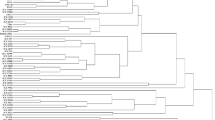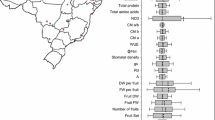Summary
A collection of populations and cultivars of Cicer arietinum L. were studied to obtain phenotypic, genotypic and environmental correlation coefficients, and broad sense heritabilities. Principal Component Analyses were performed on phenotypic, genotypic and environmental matrices. Data and phase obtained on a pure morphological basis, as well as on quantitative genetic studies and geographical distribution support the existence of two complexes within the cultivated chickpea, macrosperma and microsperma. These taxa differ in a cluster of complex characters associated with seed. pod and leaf morphology, and they differ in distribution. There is no taxonomic basis to treat these as subspecies. We propose to include C. reticulatum Lad., the wild chickpea, as a subspecies of C. arietinum, with the cultivated kinds recognized as subspecies arietinum. Race macrosperma was derived from race microsperma through selection during relatively recent times of the evolutionary history of the chickpea.
Similar content being viewed by others
References
Cubero, J. I., 1975. Research on the chickpea in Spain. International Workshop of Grain Legumes: 107–112.
De, Candolle, A., 1886. Origin of cultivated plants. Third printing of second edition. Hafner Publishing Co., New York, 1967.
Falconer, D. S., 1960. Introduction to quantitative genetics. Oliver and Boyd, Edinbourgh.
Harlan, J. R. & J. M. J., de, Wet, 1971. Toward a rational classification of cultivated plants. Taxon 20: 509–517.
Ladizinsky, G., 1975. A new Cicer from Turkey. Notes R. Bot. Gard. Edin. 34: 201–202.
Ladizinsky, G. & A., Adler, 1975. The origin of chickpea as indicated by seed protein electrophoresis. Israel J. Bot. 24: 183–189.
Ladizinsky, G. & A., Adler, 1976a. The origin of chickpea Cicer arietinum L. Euphytica 25: 211–217.
Ladizinsky, G. & A., Adler, 1976b. Genetic relationships among the annual species of Cicer L. Theor. Appl. Genetics 48: 197–203.
Moreno, M.-Teresa, 1978. Variabilidad intraespecifica en Cicer arietinum L. Tesis doctoral, Univ. Complutense, Madrid.
Murty, B. R., 1975. Biology of adaptation in chickpea. International workshop of Grain Legumes: 239–251. Hyderabad.
Narayan, R. K. J. & A. J., Macefield, 1976. Adaptive responses and genetic divergence in a world germplasm collection of chickpea (Cicer arietinum L.) Theor. Appl. Genetics 47: 179–187.
Popov, M. G., 1929. The genus Cicer and its species. Bull. Appl. Bot. Genet. Pl. Breeding 21: 1–254.
Van der Maesen, L. J. G., 1972. Cicer L. A monograph of the genus with special reference to the chickpea (Cicer arietinum L.) its ecology and cultivation. Thesis Agric. Univ. Wageningen. 342pp.
White, K. D., 1970. Roman farming. Cornell University Press.
Zohary, D. & Maria, Hopf, 1973. Domestication of pulses in the old world. Science 182: 887–894.
Author information
Authors and Affiliations
Rights and permissions
About this article
Cite this article
Moreno, MT., Cubero, J.I. Variation in Cicer arietinum L.. Euphytica 27, 465–485 (1978). https://doi.org/10.1007/BF00043173
Received:
Issue Date:
DOI: https://doi.org/10.1007/BF00043173




